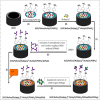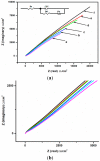Application on gold nanoparticles-dotted 4-nitrophenylazo graphene in a label-free impedimetric deoxynivalenol immunosensor
- PMID: 25668213
- PMCID: PMC4367389
- DOI: 10.3390/s150203854
Application on gold nanoparticles-dotted 4-nitrophenylazo graphene in a label-free impedimetric deoxynivalenol immunosensor
Abstract
In this paper, we report a new concept to construct a label-free electrochemical inhibition-based immunosensor for the detection of the mycotoxin deoxynivalenol (DON) in cereal samples. The electrochemical impedance spectroscopy of tris(bipyridine) ruthenium (II) chloride was used as a marker enhanced with gold nanoparticles-dotted 4-nitrophenylazo functionalized graphene (AuNp/G/PhNO2) nanocatalyst mediated in Nafion on a glassy carbon electrode. Under the optimized conditions, the formation of immunocomplexes inhibited electron flow and increased the charge transfer resistance of the sensing interface linearly. The change in impedance was proportional to DON concentrations in the range of 6-30 ng/mL with a sensitivity and detection limit of 32.14 ΩL/ng and 0.3 µg/mL, respectively, which compares favorably with the ELISA result. The proposed sensor had a stability of 80.3%, good precision and selectivity in DON standard solution containing different interfering agents, indicating promising application prospect for this strategy in designing impedimetric, electrochemiluminescent, voltammetric or amperometric sensors.
Figures















References
-
- Hajjaji A., El Otmani M., Bouya D., Bouseta A., Mathieu F., Collin S., Lebrihi A. Occurrence of Mycotoxins: Ochratoxin a, Vomitoxin (Deoxynivalenol) and Toxigenic Fungi in Moroccan Wheat Grains: Impact of Ecological Factors on the Growth and Ochratoxin a Production. Mol. Nutr. Food Res. 2006;10:1–12. - PubMed
-
- Christina N.M., Szilard F.N., Livia B., Joseph M., Bela V. Hydrogen Bondings in Deoxynivalenol (Don) Conformations—A Density Functional Study. J. Mol. Struct. 2005;3:55–59.
-
- Gouze M.E., Laffitte J., Dedieu G., Galinier A., Thouvenot J.P., Oswald I.P., Galtier P. Individual and Combined Effects of Low Oral Doses of Vomitoxin (Deoxynivalenol) (Don) and Nivalenol in Mice. Ferment. Biotechnol. 2005;51:13–18. - PubMed
-
- Monographs on the Evaluation of the Carcinogenic Risk of Chemicals to Man. International Agency for Research on Cancer; Lyon CEDEX, France: 1993.
Publication types
MeSH terms
Substances
LinkOut - more resources
Full Text Sources
Other Literature Sources

